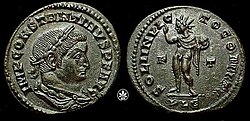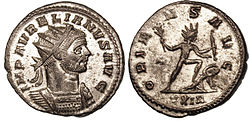Sol Invictus
- For the folk music band, see Sol Invictus (band).
Sol Invictus ("the Unconquered Sun") or, more fully, Deus Sol Invictus ("the Unconquered Sun god") was a religious title applied to at least three distinct deities during the later Roman Empire: El Gabal, Mithras, and Sol.
The earlier cult of Sol Indiges ("the native sun" or "the invoked sun")[1] was agrarian. The title Deus Sol Invictus was formed similar to the imperial titulature pius felix invictus ("dutiful, fortunate, unconquered").
The Romans held a festival on December 25 called Dies Natalis Solis Invicti, "the birthday of the unconquered sun." The use of the title Sol Invictus allowed several solar deities to be worshipped together, including Elah-Gabal, a Syrian sun god; Sol, the patron god of Emperor Aurelian (AD 270-274); and Mithras, a soldiers' god of Persian origin.[2] Emperor Elagabalus (218-222) introduced the festival, and it reached the height of its popularity under Aurelian, who promoted it as an empire-wide holiday that was a possible inspiration of Christmas.[3][4]
Sol Invictus Media
Dedication made by a priest of Jupiter Dolichenus on behalf of the well-being (salus) of the emperors, to Sol Invictus and the Genius of the military unit equites singulares Augusti
Coin of Emperor Constantine I depicting Sol Invictus with the legend SOLI INVICTO COMITI, c. 315
Identical reverse as the coin of Constantine I but with Emperor Licinius on head
Aurelian in his radiate crown, on a silvered bronze coin struck at Rome, 274–275
Mosaic in the Beth Alpha synagogue, with the Sun in the centre, surrounded by the twelve zodiac constellations and with the four seasons associated inaccurately with the constellations
Notes
- ↑ the etymology and meaning of the word "indiges" is disputed
- ↑ ""Mithraism", The Catholic Encyclopedia, 1913.
- ↑ "Sol." Encyclopædia Britannica, Chicago (2006).
- ↑ "Sol Invictus and Christmas". penelope.uchicago.edu. Retrieved 2017-12-24.
Further reading
- Halsberghe, L. 1972. The Cult of Sol Invictus (Leiden)
Other websites
- Encyclopedia Britannica Online: Sol
- Probus and Sol, includes images of coins Archived 2005-04-03 at the Wayback Machine
- Roman-Emperors: Aurelian Archived 2021-05-07 at the Wayback Machine
- Gibbon's Decline and Fall: Triumph of Aurelian
- Gibbon's references for Aurelian's Temple of Sol Invictus
- Clement A. Miles, Christmas in Ritual and Tradition, Christian and Pagan (1912): December 25 and the Natalis Invicti
- Catholic Encyclopedia (1908): Christmas
- Ancient sources
| Wikimedia Commons has media related to Lua error in Module:Commons_link at line 62: attempt to index field 'wikibase' (a nil value).. |







